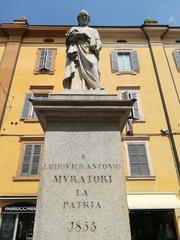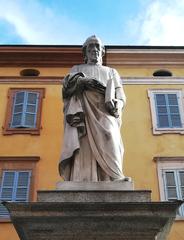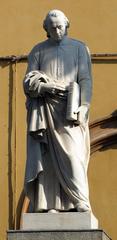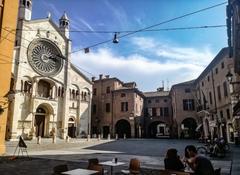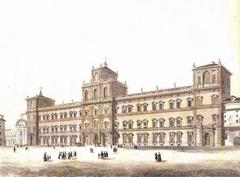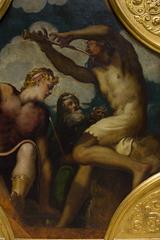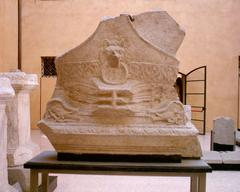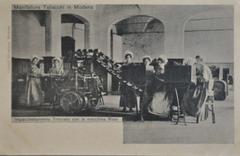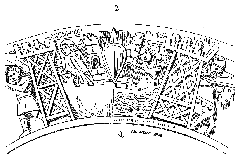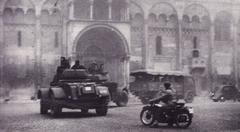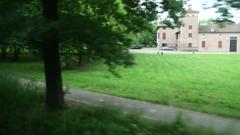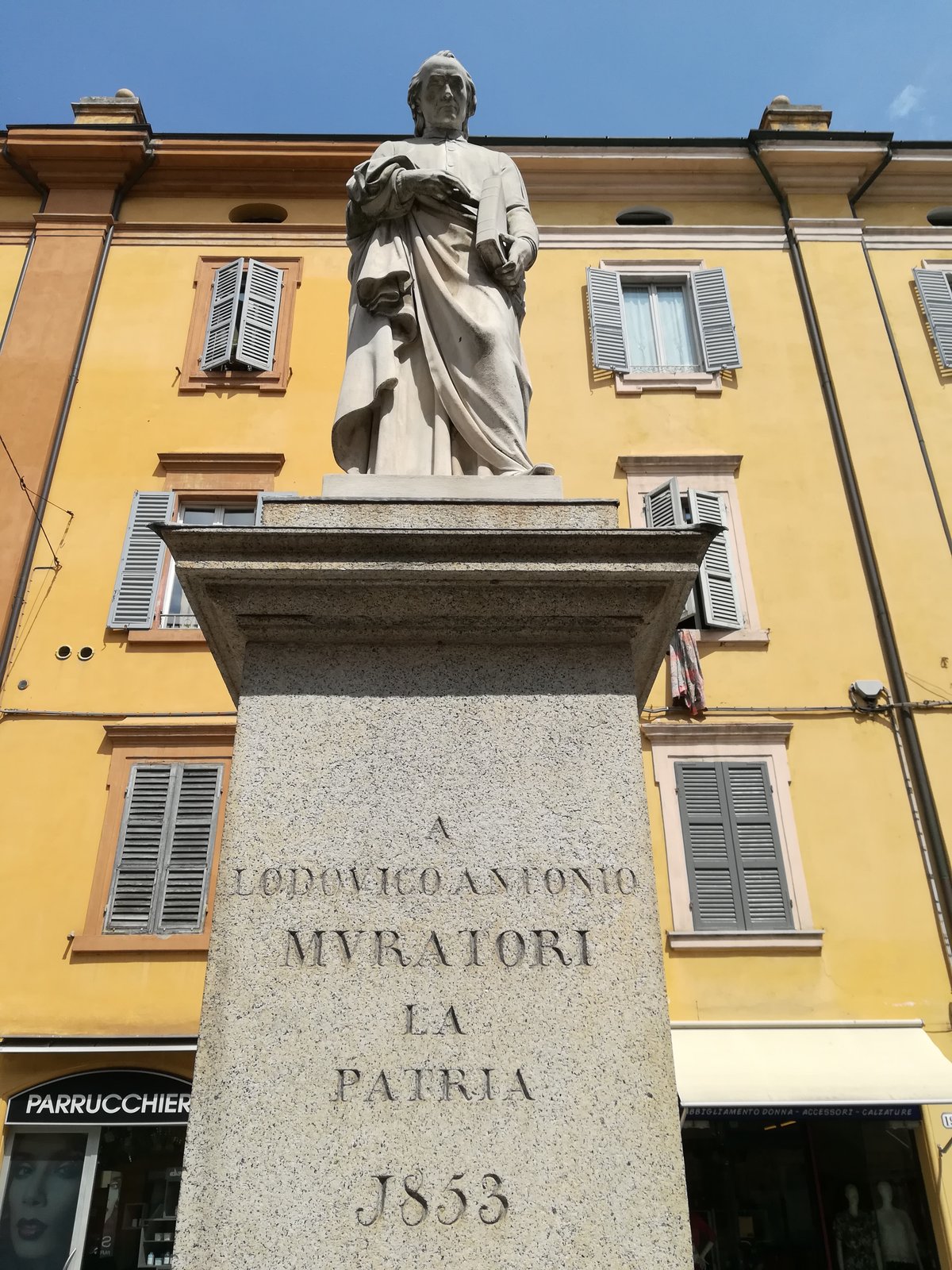
Monumento a Ludovico Antonio Muratori: Visiting Hours, Tickets, and Guide in Modena, Italy
Date: 03/07/2025
Introduction
In the heart of Modena, Italy, stands the Monumento a Ludovico Antonio Muratori—a tribute to one of the nation’s most influential historians, scholars, and Enlightenment thinkers. More than just a statue, this monument and its surrounding sites offer visitors an immersive journey into the intellectual, cultural, and spiritual heritage of Modena. This comprehensive guide covers Muratori’s life, his enduring legacy, detailed visiting information, and practical tips for making the most of your visit to this remarkable historical site.
Table of Contents
- Early Life and Education of Ludovico Antonio Muratori
- Professional Career and Major Works
- Impact on Historiography and National Identity
- Religious and Social Engagement
- Visiting the Monumento and Museo Muratoriano
- Aedes Muratoriana Complex Overview
- Practical Visitor Information
- Cultural Significance and Final Recommendations
- Sources and Further Reading
Early Life and Education
Ludovico Antonio Muratori was born on October 21, 1672, in Vignola, Duchy of Modena. From modest beginnings, he received a Jesuit education and earned degrees in philosophy, law, and letters at the Modena “Pubblico Studio.” Early mentorship by Father Benedetto Bacchini, librarian to the Dukes of Modena, steered Muratori toward historical-critical methods inspired by the French Maurists—a foundation for his future groundbreaking scholarship (Encyclopedia.com, Visit Modena, Britannica).
Professional Career and Major Works
After his ordination as a priest in 1694, Muratori’s career blossomed at Milan’s Ambrosian Library, where he published previously unknown Latin manuscripts. Returning to Modena in 1700, he became archivist and librarian for Duke Rinaldo I d’Este—a role he held for life, safeguarding Modena’s archives through turbulent times.
Muratori’s most influential works include:
- Rerum Italicarum Scriptores (1723–1751): A 28-volume compendium of Italian historical sources, pivotal in shaping modern historiography (Enlightenment Revolution).
- Antiquitates Italicae Medii Aevi (1738–1742): Seventy-five dissertations on medieval Italian history (Theodora Encyclopedia).
- Annali d’Italia (1744–1749): A 12-volume chronological history accessible to a broad audience (Enlightenment Revolution).
- The Muratorian Canon: His discovery of the earliest known list of New Testament books remains pivotal in biblical studies (Encyclopedia.com).
Impact on Historiography and National Identity
Muratori is regarded as the father of modern Italian historiography. He advanced rigorous, source-based methods that moved Italian scholarship beyond the theological and moralistic traditions of the Counter-Reformation (Theodora Encyclopedia, Encyclopedia.com). His Annali d’Italia fostered national pride and unity by highlighting the importance of medieval Italy in shaping the modern nation—ideas that influenced the later Risorgimento (Enlightenment Revolution).
Religious and Social Engagement
As provost of Santa Maria della Pomposa (1716–1733), Muratori restored the church, engaged in charity, and advocated for religious and legal reform (Visit Modena). His works, such as Della Regolata Divizione dei Cristiani (1747), promoted unity and moderation within the Catholic Enlightenment (Enlightenment Revolution). Muratori corresponded with over 2,000 European intellectuals, including Leibniz, and was respected by the highest ecclesiastical authorities (Wikipedia).
Visiting the Monumento and Museo Muratoriano
Visiting Hours and Tickets
- Monument: The outdoor statue near Santa Maria della Pomposa is accessible 24/7.
- Museo Muratoriano: Open Tuesday–Sunday, 10:00 AM–6:00 PM (closed Mondays and holidays).
- Admission: Monument and church are free. Museo Muratoriano tickets are €5 (discounts for students/seniors).
Accessibility
The museum is wheelchair accessible. The church and nearby monument offer limited accessibility due to historic architecture, but staff assistance is available.
Getting There
Located in central Modena, the sites are a short walk from the train station and city landmarks. Public transit and nearby parking (limited) are available.
Nearby Attractions
Combine your visit with the Modena Cathedral, Piazza Grande, Ducal Palace, and Via Emilia shopping street.
Special Events and Guided Tours
Guided tours are available on weekends and by appointment; the museum also hosts exhibitions and lectures. For updates, visit the Museo Muratoriano website.
Aedes Muratoriana Complex Overview
Church of Santa Maria della Pomposa
A 12th-century church rebuilt under Muratori’s guidance in the 18th century, featuring works by Bernardino Cervi and Jean Boulanger, elegant scagliola, and Muratori’s tomb crafted by Ludovico Pogliaghi in 1931 (laguidadimodena.it).
Muratori’s Tomb and Museum
Muratori’s tomb is in the first chapel left of the church entrance. The Museo Muratoriano, established in 1931, preserves his home, library, manuscripts, and memorabilia (laguidadimodena.it).
Deputazione di Storia Patria
The headquarters of this historical society, founded in 1860, are within the complex. It publishes the “Atti e Memorie” journal and supports local historical research (visitmodena.it).
Practical Visitor Information
Location and Directions
Aedes Muratoriana is at Via Pomposa 1, 41121 Modena—10 minutes’ walk east from Modena Cathedral or accessible by bus from the train station.
Accessibility and Amenities
The museum offers ramps and elevators. The church and monument are mostly accessible; contact staff for specific needs.
Visitor Tips
- Best Times: Weekday mornings are least crowded.
- Dress Code: Modest attire required for the church.
- Tours: Book in advance for groups and guided experiences.
- Photography: Allowed without flash, but check with staff for restrictions.
Frequently Asked Questions (FAQs)
Q: What are the monument and museum hours?
A: The monument is outdoors and always accessible. The museum is open Tuesday–Sunday, 10:00 AM–6:00 PM.
Q: Is there an admission fee?
A: The monument and church are free; museum entry is €5 (concessions available).
Q: How do I book tickets or tours?
A: Tickets at the museum or via the Modena tourism website; guided tours by appointment.
Q: Is the site accessible for wheelchairs?
A: The museum is fully accessible; the church and monument have some historic limitations.
Q: Can I take photos?
A: Yes, without flash, subject to any posted restrictions.
Cultural Significance and Final Recommendations
The Monumento a Ludovico Antonio Muratori and the Aedes Muratoriana complex are cornerstones of Modena’s intellectual and civic identity. These sites offer a unique opportunity to explore the legacy of a scholar who shaped Italian historiography and inspired Enlightenment ideals of inquiry and reform. Their integration with Modena’s UNESCO-listed historical center makes them a must-visit for anyone interested in culture, history, or art.
To enhance your experience, plan to allocate 1–2 hours for a thorough visit, take advantage of guided tours, and explore nearby historical attractions. Check official sources for the latest on hours, events, and accessibility. For an enhanced, app-based visitor experience, download the Audiala app and follow us on social media.
Sources and Further Reading
- Visit Modena
- BBC Analino 21
- La Guida di Modena - Aedes Muratoriana
- La Guida di Modena - Santa Maria della Pomposa
- Encyclopedia.com
- Britannica
- Wikipedia
- Enlightenment Revolution
- Theodora Encyclopedia
- La Guida di Modena - Modena History
- Evendo.com
